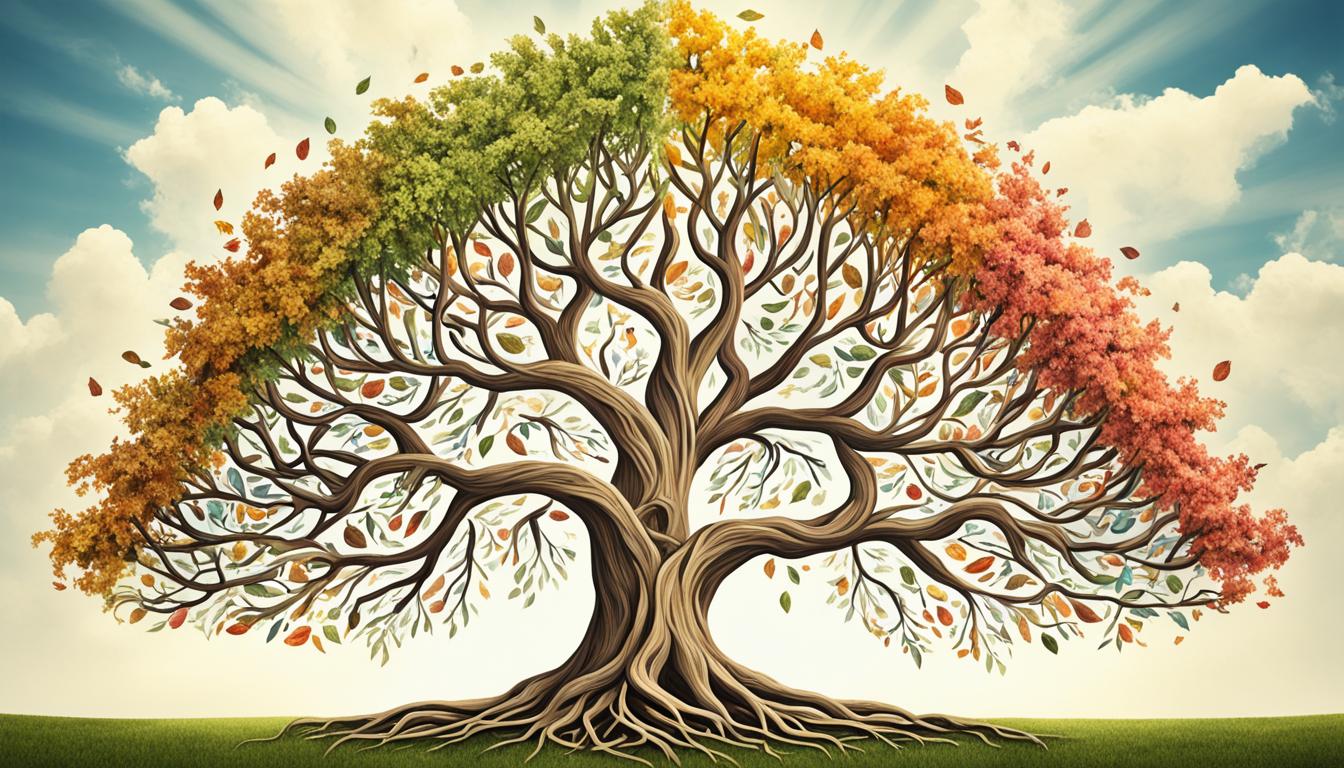When it comes to long-term relationships, many factors contribute to their duration and success. From the initial stages of intense love to navigating through challenges, maintaining a healthy long-term relationship requires effort and understanding. In this article, we will explore the stages of long-term relationships and the key factors that contribute to their longevity.
Key Takeaways:
- Long-term relationships go through stages, including the Merge, Doubt and Denial, Disillusionment, Decision, and Wholehearted Love.
- These stages are cyclical and not necessarily sequential throughout the relationship.
- The Merge stage, also known as the honeymoon stage, can last from two weeks to two years.
- Effective communication, trust, mutual respect, and alignment in core values are crucial for maintaining a long-term relationship.
- Nurturing emotional bonds, expressing love and affection, adapting to change, and having shared interests play significant roles in relationship longevity.
Factors Affecting Long-Term Relationships
When it comes to long-term relationships, understanding the factors that can affect their success is crucial. As couples progress through the stages of a relationship, they often encounter challenges that can test their bond. The second stage, known as Doubt and Denial, is where differences and issues start to arise.
During this stage, power struggles and disagreements become more common. It’s important to remember that these conflicts are a natural part of any relationship and can be overcome with effective communication and a willingness to seek help when needed.
“In a lasting relationship, it’s essential to have open and honest conversations about your concerns and work together to find solutions,” says relationship expert Sarah Thompson.
Following Doubt and Denial, the third stage is Disillusionment. In this stage, unresolved problems and conflicts that have been simmering underneath the surface start to come to light. Couples may experience fights, a lack of connection, and feelings of disapproval.
However, it’s important to remember that Disillusionment can also be a turning point for positive change. By fostering open communication and seeking support, couples can address these issues head-on and deepen their understanding of one another.
In order to maintain a healthy and lasting relationship, several key characteristics and behaviors are essential. These include:
- Trust: Building and maintaining trust is vital for a long-term relationship to thrive. Trust is established through consistent actions and an alignment of values.
- Mutual respect: Respect involves valuing each other’s opinions, boundaries, and individuality. It is the foundation upon which a healthy relationship is built.
- Open communication: Effective and open communication allows couples to express their thoughts and feelings honestly, fostering a deeper understanding and connection.
- Intimacy: Intimacy encompasses emotional, intellectual, and physical closeness. Nurturing intimacy is essential for maintaining a strong and lasting bond.
- Adaptability: Being adaptable and flexible in the face of challenges and changes is crucial. Couples who can navigate life’s ups and downs together are more likely to have a lasting relationship.
- Shared interests: Having shared interests and activities strengthens the bond between partners, fostering a sense of companionship and togetherness.
Image:

Maintaining a Long-Term Relationship
In order to maintain a long-term relationship, it’s crucial to prioritize quality time together. Creating space in your busy schedules to spend meaningful moments with each other helps nurture emotional bonds and strengthen your connection. Whether it’s going on date nights, taking walks together, or simply enjoying quiet evenings at home, these shared experiences contribute to the longevity of your relationship.
Expressing love and affection regularly is also vital. Small gestures like saying “I love you,” hugging, or holding hands reaffirm your commitment to each other and keep the flame of love alive. Even simple acts of kindness and appreciation can go a long way in maintaining a deep bond.
Adaptability is key when it comes to the ever-changing nature of relationships. Life throws curveballs, and both individuals in the relationship will grow and evolve over time. Being open to change and embracing growth as individuals and as a couple is essential for long-term success. This means being willing to compromise, find common ground, and adapt to new circumstances.
Trust and respect are the cornerstones of a lasting relationship. Cultivating trust involves consistently demonstrating honesty, reliability, and integrity. It also means respecting each other’s boundaries, opinions, and decisions. When actions align with core values, trust and respect are strengthened, creating a solid foundation for the relationship to thrive.
Open communication is a crucial aspect of maintaining a healthy long-term relationship. Effective communication involves active listening, expressing thoughts and feelings honestly, and addressing any concerns or issues that may arise. Authentic and vulnerable communication helps foster understanding, empathy, and connection.
Emotional intelligence, relatability, and friendship are additional factors that contribute to the strength of a long-term relationship. Emotional intelligence enables you to understand and navigate each other’s emotions, fostering empathy and deepening your connection. Relatability allows you to find common ground and relate to each other’s experiences, creating a sense of camaraderie. Friendship plays a vital role as a foundation of trust, shared interests, and mutual support.

Appreciating and supporting each other’s personal growth is crucial for the longevity of a relationship. Encouraging and celebrating the achievements and aspirations of your partner helps create a supportive and nurturing environment. Additionally, having shared interests and hobbies strengthens your bond and provides opportunities for connection and enjoyment.
By prioritizing quality time, nurturing emotional bonds, expressing love and affection, adapting to change, cultivating trust and respect, practicing open communication, embracing emotional intelligence, relatability, and friendship, and supporting each other’s personal growth, you can maintain a long-term relationship that stands the test of time.
What Makes Love Last?
In a healthy long-term relationship, several important traits contribute to its longevity and fulfillment. These traits include trust, mutual respect, alignment in core values, open communication, emotional intelligence, intimacy and affection, adaptability, and friendship with shared interests.
Trust is fundamental in building a strong foundation for a lasting relationship. It is established through consistent actions that align with core values, creating a sense of security and reliability.
Mutual respect involves valuing each other’s opinions, boundaries, and individuality. It fosters a supportive and equal partnership.
Open communication allows for authentic expression and vulnerability. It enables both partners to share their thoughts, feelings, and concerns, fostering understanding and connection.
Emotional intelligence plays a crucial role in understanding and empathizing with each other’s emotions. It involves recognizing and managing emotions within the context of the relationship, leading to deeper understanding and connection.
Intimacy goes beyond physical affection; it includes emotional and intellectual closeness. Intimate moments foster a sense of vulnerability, connection, and deep bond.
Adaptability is vital in a long-term relationship as it allows both partners to embrace and accommodate change and growth. This trait enables the relationship to evolve and withstand the challenges that life may bring.
A strong underlying friendship with shared interests provides a foundation for a lasting relationship. Having common hobbies and activities fosters a sense of companionship and enhances the bond between partners.

By nurturing these traits, a couple can build a lasting bond that not only stands the test of time but also brings joy, fulfillment, and growth. Recognizing and embracing the factors that contribute to the longevity of love can help couples create a strong and satisfying relationship.
Conclusion
In conclusion, building a lasting and fulfilling love requires effort and attention to various aspects. Trust, mutual respect, core value alignment, open communication, emotional intelligence, intimacy, adaptability, and friendship with shared interests are crucial for the longevity of a relationship. By prioritizing and nurturing these traits, you can create a bond that withstands the test of time.
Recognizing the stages of a relationship and addressing challenges is essential. Understanding that relationships go through cycles and seeking support when needed can help you navigate the ups and downs. Remember, no relationship is perfect, but by consistently working on these aspects, you can forge a strong and lasting connection.
Investing quality time, nurturing emotional bonds, expressing love and affection, and adapting to changes are key to maintaining a long-term relationship. Trust and respect should be cultivated through actions that align with your shared values. Keeping the lines of communication open, being emotionally intelligent, and having a strong underlying friendship with shared interests further strengthens the foundation of your relationship.
Ultimately, what makes love last is a combination of these factors. By incorporating trust, respect, communication, emotional intelligence, intimacy, adaptability, and friendship into your relationship, you create an environment where love can thrive and endure. So, commit to these traits and enjoy a love that stands the test of time.
FAQ
How long is considered a long-term relationship?
The duration of a long-term relationship can vary, but it generally refers to a committed partnership that lasts for several years or more. There is no specific timeframe, as individuals and couples define long-term differently.
What are the stages of a long-term relationship?
Research shows that long-term relationships go through five stages: Merge, Doubt and Denial, Disillusionment, Decision, and Wholehearted Love. These stages are not sequential but an ongoing cycle throughout the length of the relationship.
What are the signs of a lasting relationship?
Some signs of a lasting relationship include trust, mutual respect, alignment in core values, open communication, emotional intelligence, intimacy, adaptability, and a strong underlying friendship with shared interests.
How can I maintain a long-term relationship?
To maintain a long-term relationship, it’s crucial to prioritize quality time together, nurture emotional bonds, express love and affection regularly, adapt to changes and growth, and have open and effective communication. Trust, mutual respect, and shared interests also play significant roles.
What traits contribute to the longevity of love in a long-term relationship?
Trust, mutual respect, alignment in core values, open communication, emotional intelligence, intimacy and affection, adaptability, and friendship with shared interests are some of the traits that contribute to the longevity of love in a long-term relationship.
Source Links
- https://12weekrelationships.com/what-makes-love-last-8-traits-of-healthy-long-term-relationships/
- https://deborahbyrnepsychologyservices.com/the-5-stages-of-a-long-term-relationship/
- https://medium.com/the-secret-society/what-nobody-talks-about-when-it-comes-to-long-term-relationships-ade462874cf2


